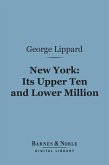In "New York: Its Upper Ten and Lower Million," George Lippard crafts a vivid panorama of 19th-century New York City, illuminating the stark contrasts between the affluent elite and the impoverished masses. Through his incisive prose and dramatic narrative style, Lippard explores themes of social inequality, corruption, and the quest for justice, drawing inspiration from the burgeoning urban landscape and the era's rapidly changing socio-economic conditions. The book, published in 1854, is notable for its blend of fiction and social criticism, capturing the zeitgeist of a city in transformation, making it a significant contribution to American literary realism. George Lippard, an ardent social reformer and journalist, was deeply influenced by the conditions of urban poverty he witnessed during his lifetime. His commitment to social justice stemmed from his early experiences in Philadelphia, where he became an advocate for the disenfranchised. This passion is palpable in his writing, reflecting his belief in literature as a powerful tool for social change. Lippard's work serves as both a critique of the capitalist excesses of his time and a call to action for his contemporaries. This book is highly recommended for readers interested in American history and literature, as it provides a poignant glimpse into the struggles of different social classes within a rapidly industrializing society. Lippard's compelling narrative not only invites reflection on historical inequalities but also prompts contemporary discussions about social justice, making it an essential read for those seeking to understand the complexities of urban life.
Dieser Download kann aus rechtlichen Gründen nur mit Rechnungsadresse in A, B, BG, CY, CZ, D, DK, EW, E, FIN, F, GR, H, IRL, I, LT, L, LR, M, NL, PL, P, R, S, SLO, SK ausgeliefert werden.









